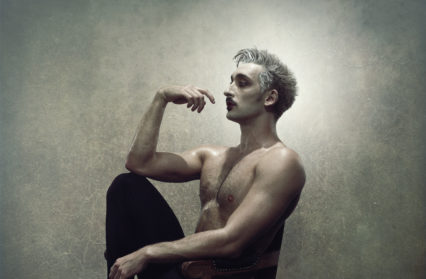An adaptation of Ian Kelly’s biography, Northern Ballet’s latest production, Casanova, seeks to illuminate the myriad, lesser known, personality traits and accomplishments, of the man who has been defined by his extensive sexual conquests. Whilst aspects of Casanova’s multifaceted nature are touched upon, the overarching theme of the production is unquestionably the decadent promiscuity of the man.
The medium of ballet provides the perfect platform to portray Casanova’s sexual escapades in an unambiguous, yet poetic fashion, and Kenneth Tindall’s choreography succeeds in doing just that; entwining limbs and provocative lifts leave little doubt as to the action unfolding, especially when coupled with Christopher Oram’s alluring costumes.
Gorgeous ballerinaesque dresses, are coupled with thigh high stockings; each balletic lift of their legs revealing a tantalising glimpse of skin, often forming an enticing accompaniment to the brazenly bare-chested Casanova. Despite his impressively carved physique, at times, Javier Torres lacks the smouldering physicality and commanding stage presence Casanova demands. As the leading soloist, Torres’ role is demanding and his stamina is tested to the limits as the performance progresses, and the strain begins to show slightly.
At times Tindall’s choreography is inspired; delicate intimacy giving way to hard recrimination, yet some momentum is lost in the second act. The middle section begins to stagnate, falling into repetition and scenes with too many similarities to differentiate themselves. Although, the duet between Javier Torres and Antoinette Brooks-Daw, as Henriette, is nothing short of stunning, as is the dramatic ending, full of darkness and decadence.
There are many such stand-out moments of dancing throughout the piece, however the cast lack a certain level of finesse, not quite dancing in synchronicity, and therefore failing to achieve the purity of movement which elevates a ballet from beautiful to spectacular. Much of Casanova’s beauty lies within Christopher Oram’s breath-taking set and costume design. Both act’s sets are ornamental; towering golden pieces, exuding opulence and grandeur, but there are marked differences to portray the different cities’ styles, echoed in the costumes.
Act One’s Venetian backdrop is impenetrable and imposing, its opening scene setting the tone with a dark sense of gravitas, utilising all the weight the might of the Church brings to bear. Bold colours and materials feature heavily, with plenty of black lace and red velvets. In comparison, Act Two’s Parisian touch is far softer; chiefly pinks and blues, silks and satin. The set is warmer, whilst still ornate; large golden-rimmed mirrors opening up to replicate the ballet dancers in their semi-reflective glass. The style is unmistakably 18th century, yet contemporised to complement this modern depiction of a well-known, yet largely misunderstood, historical figure.
With a ballet’s musical score being so pivotal to its storyline, the presence of a live orchestra does much to breathe life into Kerry Muzzey’s vision to transport the audience into the world of Casanova, with his cinematic score. Unfortunately, it proves difficult to be entirely immersed in the performance, as the episodic storyline is near impossible to follow, with so many different characters flitting on and off the stage. In his eagerness to convey the many different aspects of Casanova, it appears Tindall has overreached, attempting to cram too much into too tight a timeframe, thus sacrificing the opportunity to establish any true character depth.
Despite its flaws, Casanova is a ballet of great beauty, and if not fully successful in educating audiences in the details of Giacomo Casanova’s life, it at least prompts the realisation that there was more to the man.












